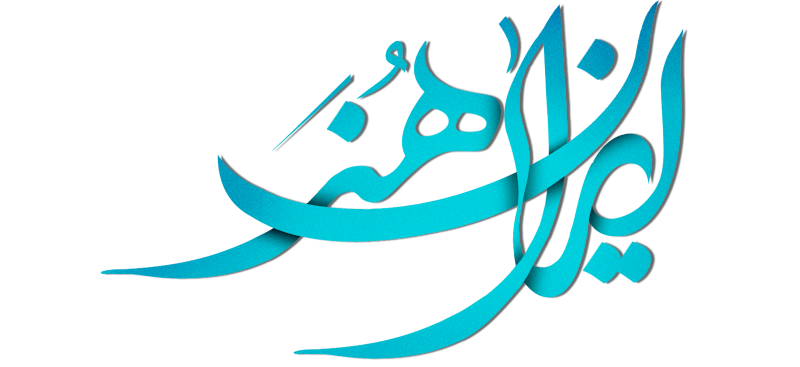Ali Shirazi | Ali Shirazi Calligraphy
Iranian Nastaliq with Arabic Calligraphy by Ali Shirazi

Ali Shirazi and Iranian Nastaliq with Arabic Calligraphy
IranArt : This study examines the endearing Arabic adage "Sharaf al-Makan Bal-Makin," which was rendered in Persian Nastaliq calligraphy by famed Middle Eastern calligrapher Ali Shirazi.
1:
It's pleasant and challenging in its own right to write Arabic sentences in Persian calligraphy. The renowned Middle Eastern calligrapher Ali Shirazi used a 30 mm pen and his distinctive one-stroke writing style to produce an attractive, well-balanced piece.
One of the lovely Arabic proverbs, "شرف المکان بالمکین" (Sharaf al-Makan Bal-Makin), goes, "The honor of any place depends on the person who sits in that place." Because of its numerous applications, Persian speakers also frequently recite it. It is evident that writing Arabic words in the Persian-style calligraphy Nastaliq calligraphy is a task in and of itself. Fitting this three-word saying inside a rectangle box is another challenge.
2:
Persian words are the intended use for the Nastaliq calligraphy, which has an odd adaption to the writing system of this language. Nastaliq begins on the right, above the horizontal line. After that, it is progressively settled on the gently sloping standard line. Calligraphers have a little difficulty creating such phrases because Arabic words generally include a "al" ("ال"), which makes the lines taller, and also have longer syllables.
The Thuluth was designed to write in Arabic and does so with excellent reflection. The intersection of letters and words is common in Thuluth compositions, which are based on the horizontal standard line. On the other hand, Nastaliq calligraphy only commonly uses word crossings in Siyah Mashq or Black Practice.
Yet a floating standard line in Nastaliq calligraphy opens up numerous possibilities for the calligrapher's creativity. Shirazi has used this foundation to produce an exquisite and striking fusion of Arabic text with Persian calligraphy.

3:
With just three phrases in this well-known aphorism, the artist had to figure out how to combine the letters to create visual beauty in a tiny frame. The letter "f" ("ف") is elongated, and it is clear the overextension was done on purpose. The artist came up with this as an initial solution. The accentuated "f" ("ف") in the rectangular box has led to a balance between the words "al-Makan" ("المکان") and "al-Makin" ("المکین").
4:
Take a close look at the two "n" ("ن") in this frame. They bring attention to themselves with their harmony and lovely rhythm.
5:
The skillful arrangement of two "l-M" ("لم ") in this piece of art is something we cannot overlook. Furthermore, note how the skilled calligrapher has covered the two "k" ("ک ") letters in the present case, which are typically noticeable in their unkempt stretching because of the unique composition.
6:
The harmony, consistency, and fluidity of the entire piece, which is based on the master calligrapher's so-called one-stroke writing technique, are what initially draw in viewers to the artwork. With the use of the right ink, the calligrapher appears to have constructed the item as part of a calligraphic act, adding depth, lightness, and shade.
The calligraphy world views Shirazi as unique in two ways in the modern era: first, his proficiency with huge pens, and second, his ability to write with the same pens in a single stroke. He stands apart from other artists in this area because of his mixture of both of these characteristics, which is also evident in this piece of art.
7:
A 30 mm pen is used to write "Sharaf al-Makan Bal-Makin". Experts understand that when the pen size increases in calligraphy, it becomes increasingly difficult to write in line with the known and fundamental norms of original calligraphy.
8:
The piece demonstrates extremely skilled calligraphy, covering fundamental concepts of dot arrangement and size balance. Shirazi is an unrivaled expert due to his focus on the aforementioned elements.
9:
Illuminated manuscripts have always been used in Islamic calligraphy to elevate the art form and religious and ceremonial writings. This work of art contains an intriguing reading between the illuminated manuscript within the frame and the visually appealing illuminated manuscript beyond the frame. The Illuminated manuscript, which is made based on the composition and greater visibility of the calligraphy, is one benefit of the job.

Shirazi's calligraphies are becoming increasingly popular in the Middle Eastern art market. Aside from his historic Christie's auction result of $60,000 in 2012, the Iranian artist has obtained extraordinary prices for highly sought-after pieces at Bonhams London and other auction houses; samples of his prior sales can be found on reputable websites such as Art Price.
Master Shirazi's work can be seen in many of the most valuable gathers in the Middle East, such as the collections of the eminent Arab poet and writer Mohammad Al Murr in the United Arab Emirates; the Al Owais Institute in Dubai; the Anwar Gargash collection in Dubai; the Juma Al Majid collection in Dubai; the museums in Sharjah, Doha, and Qatar; the most important private collectors, including Pasargad Bank of Iran; and religious collections in Iran, such as the Quran Museum and Imam Ali Religious Arts Museum in Tehran.

